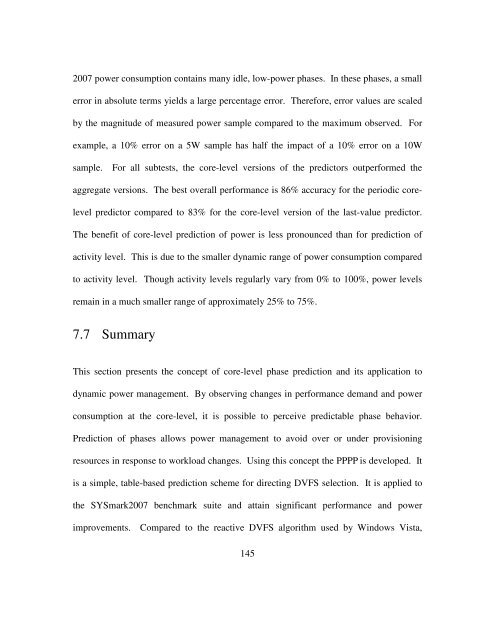Copyright by William Lloyd Bircher 2010 - The Laboratory for ...
Copyright by William Lloyd Bircher 2010 - The Laboratory for ...
Copyright by William Lloyd Bircher 2010 - The Laboratory for ...
You also want an ePaper? Increase the reach of your titles
YUMPU automatically turns print PDFs into web optimized ePapers that Google loves.
2007 power consumption contains many idle, low-power phases. In these phases, a small<br />
error in absolute terms yields a large percentage error. <strong>The</strong>re<strong>for</strong>e, error values are scaled<br />
<strong>by</strong> the magnitude of measured power sample compared to the maximum observed. For<br />
example, a 10% error on a 5W sample has half the impact of a 10% error on a 10W<br />
sample. For all subtests, the core-level versions of the predictors outper<strong>for</strong>med the<br />
aggregate versions. <strong>The</strong> best overall per<strong>for</strong>mance is 86% accuracy <strong>for</strong> the periodic core-<br />
level predictor compared to 83% <strong>for</strong> the core-level version of the last-value predictor.<br />
<strong>The</strong> benefit of core-level prediction of power is less pronounced than <strong>for</strong> prediction of<br />
activity level. This is due to the smaller dynamic range of power consumption compared<br />
to activity level. Though activity levels regularly vary from 0% to 100%, power levels<br />
remain in a much smaller range of approximately 25% to 75%.<br />
7.7 Summary<br />
This section presents the concept of core-level phase prediction and its application to<br />
dynamic power management. By observing changes in per<strong>for</strong>mance demand and power<br />
consumption at the core-level, it is possible to perceive predictable phase behavior.<br />
Prediction of phases allows power management to avoid over or under provisioning<br />
resources in response to workload changes. Using this concept the PPPP is developed. It<br />
is a simple, table-based prediction scheme <strong>for</strong> directing DVFS selection. It is applied to<br />
the SYSmark2007 benchmark suite and attain significant per<strong>for</strong>mance and power<br />
improvements. Compared to the reactive DVFS algorithm used <strong>by</strong> Windows Vista,<br />
145




